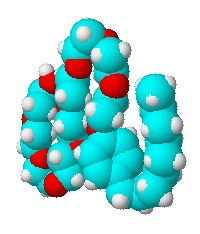Here’s one to really get the animal rights activists up in arms (as if they aren’t already). The BBC reports that scientists have been able to “introduce most of a human chromosome into mice – and create the most successful recreation of Down’s syndrome so far.” I’m not sure whether the activists will find this better or worse than the ear grown on a mouse’s back in 1999 by Joseph Vacanti. Regardless, a mouse model of the disease will inevitably lead to controversy, but more importantly, it will lead to a better understanding of the syndrome itself.
Category: Health and Medicine
Sciencebase news and views on health and medicine, including posts on Covid-19, bird flu, cancer, asthma, obesity, vaccines, and much more.
Leukencephalopathy
An unusual keyword to say the least, but someone surfing the net found sciencebase with it. So, here’s a quick definition:
Progressive multifocal leukencephalopathy (PML) is rare but debilitating. It is an inflammatory response to viral infection observed in immunocompromised patients, such as AIDS sufferers. The inflammation leads to loss of the myelin that insulates nerves within the white matter of the brain. Visual defects, headaches, and speech/language problems result.
There is no dedicated treatment but AIDS patients undergoing therapy with highly active antiretroviral therapy (HAART) often improve significantly.
Squirt George Bank Nuisance
Researchers have completed a survey of the invasive sea squirt colony on the Georges Bank. A wider area was searched for the sea squirt in 2005, and it was mapped over about twice the area observed in 2004. Results show that the species is present in two adjacent areas totaling 88 square miles in US waters near the US-Canada boundary. The very large mat-like colonies observed in 2004 have been replaced by fewer smaller ones. The Georges Bank occurrence is the largest known infestation of colonial sea squirts in a major offshore fishing ground.
And, doesn’t it lend itself to an oddly apt sounding GWB headline?
Three-parent embryo
Is it squeamishness or superstition that makes the announcement from Newcastle University of plans to create a “three-parent” embryo controversial? I cannot see a profound difference between this kind of “non-natural” method of conception and any of the plethora of IVF and related treatments. They’re all non-natural when compared to the conventional approach to conception, after all.
However, the potential benefits of this new approach could be immense, when considered from the perspective of mitochondrial disease, which it seeks to prevent. So, what’s it to be non-natural and healthy or natural and not?
Ferrets
A neighbour approached a stranger who knocked on our front door three days in a row while we were on vacation. Apparently, my ferret had been sighted in the grounds of the local school! I was so relieved…except that I don’t own a ferret. I can only asusme that there was some transient overlap with the parallel universe in which I do own a ferret…either that or the world’s gone mad (more likely).
Nonoxynol Molecular Structure
Nonoxynol features in my list of unusual and unsavoury wedding anniversary gifts on sciencebase, and as such generates a fair few hits from visitors looking for its molecular structure. So, here it is. Unusual looking beast with that large protruding group at the front there!

Visit the main site for more information on the sciencebase molecular modeling service
David Bradley
It’s not something I can claim as my own really, but my name was an answer on the US TV show Final Jeopardy some time ago. Apparently, the associated question was “Who invented the computer reset ‘Control-Alt-Delete’?” Well, it wasn’t me, but it was my namesake at IBM during the early 1980s. And, where would we all be without him? Stuck in an endless blue screen of death state I reckon.
Comments
UPDATE: 2011-11-30 It’s the last day of Movember, and I see from our laser display board that Sciencebase has passed the 2000 blog posts mark by a long margin. Apologies if you were expecting a fanfare that never came.
UPDATE: 2011-09-04 Fast approaching 2000 posts on Sciencebase since switching to WordPress. Now locked down comments to three-day open, but you should be able to add comments to all posts via Facebook.
UPDATE: 2011-05-17 We’re still here, still blogging, about 1900 posts at the time of writing and thousands of comments. Once we switched to WordPress, which is years ago now we needed to be even more vigilant with spam comments. As of this year, comments are enabled on new posts and you can offer your thoughts for a week before the articles are essentially archived and comments disabled.
I’ve enabled comments for the SciObs Sciencebase science blog, please feel free to tell me what you think…comment spam will be ruthlessly hacked to pieces and the perpetrators hounded down and spiked.
Psoriasis
Sciencebase reader “Dr Viswanath K” contacted me today with the following question: “What type of cell in the hypothalamus controls epidermopoisis/epidermokinetics?”.
There’s absolsutely no way I can claim to be an expert in this area, although I could ask an expert and provide definitions of those two terms and perhaps find a description of the types of cell involved. However, I am sure there is at least one Sciencebase reader out there who knows that answer. Feel free to leave a comment on the subject if you have any insights.
Cancer therapy side effects
There’s an interesting tale of a novel side-effect causing problems for young cancer sufferers in the UK. Nightclub bouncers it seems have been turning away cancer patients who have been rendered hairless by their treatment on the basis that they must be “skinhead thugs”. According to the Times – http://www.timesonline.co.uk/article/0,,2-2319293.html – half the young cancer patients from Manchester’s Christie Hospital have been turned away from a pub or club door. The solution was to issue the patients with a photo identity card to stop them being turned away.